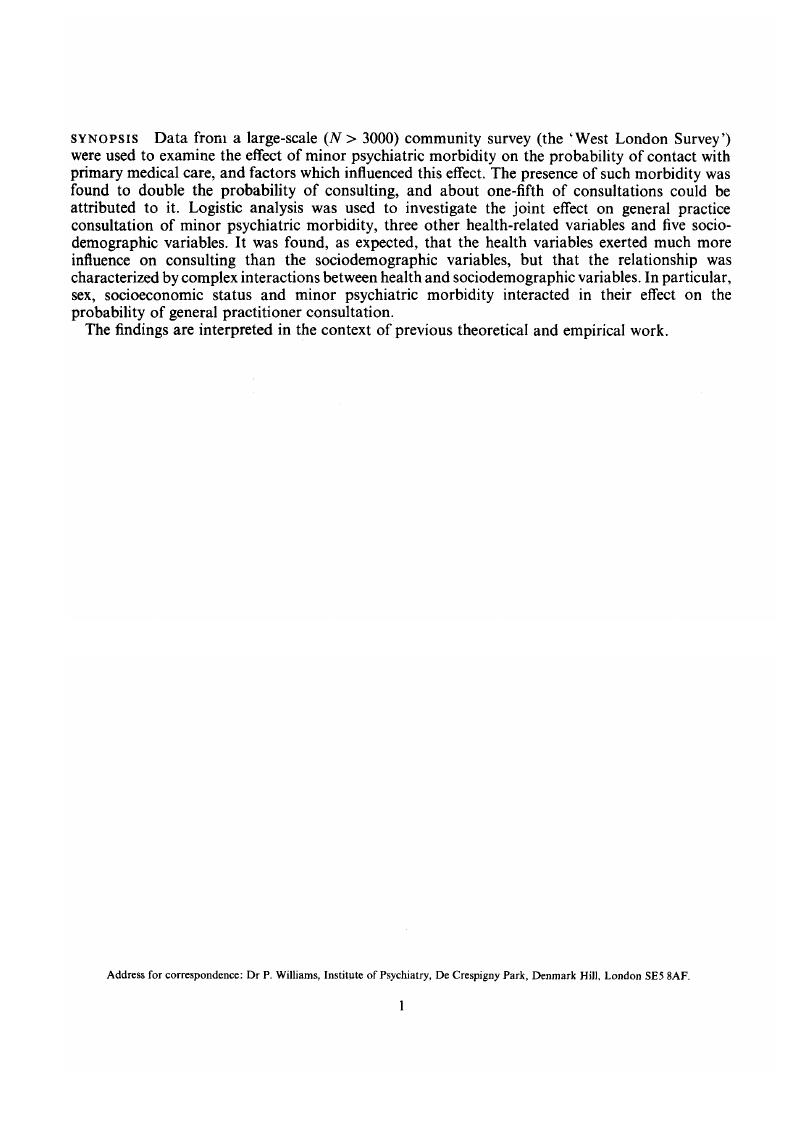Crossref Citations
This article has been cited by the following publications. This list is generated based on data provided by Crossref.
Costello, Charles G.
Devins, Gerald M.
and
Ward, Kimberley W.
1988.
The prevalence of fears, phobias and anxiety disorders and their relationship with depression in women attending family physicians.
Behaviour Research and Therapy,
Vol. 26,
Issue. 4,
p.
311.
Eisenberg, Leon
1988.
The Relationship Between Psychiatric Research and Public Policy.
British Journal of Psychiatry,
Vol. 153,
Issue. 1,
p.
21.
Wilmink, F. W.
and
Snijders, T. A. B.
1989.
Polytomous logistic regression analysis of the General Health Questionnaire and the Present State Examination.
Psychological Medicine,
Vol. 19,
Issue. 3,
p.
755.
Wilmink, F.W.
Ormel, J.
Giel, R.
Krol, B.
Lindeboom, E.G.
van der Meer, K.
and
Soeteman, J.H.
1989.
General practitioners' characteristics and the assessment of psychiatric illness.
Journal of Psychiatric Research,
Vol. 23,
Issue. 2,
p.
135.
Ormel, J.
Brink, W. Van Den
Koeter, M. W. J.
Giel, R.
Meer, K. Van Der
Willige, G. Van De
and
Wilmink, F. W.
1990.
Recognition, management and outcome of psychological disorders in primary care: a naturalistic follow-up study.
Psychological Medicine,
Vol. 20,
Issue. 4,
p.
909.
Murphy, Jane M.
1990.
Depression in the Community: Findings from the Stirling County Study.
The Canadian Journal of Psychiatry,
Vol. 35,
Issue. 5,
p.
390.
El-Islam, M. Fakhr
and
Abu-Dagga, Sanaa I.
1990.
Illness behaviour in mental ill-health in Kuwait.
Scandinavian Journal of Social Medicine,
Vol. 18,
Issue. 3,
p.
195.
Tansella, M.
1991.
6. Community care without mental hospitals: ten years' experience.
Psychological Medicine. Monograph Supplement,
Vol. 19,
Issue. ,
p.
47.
1991.
References.
Psychological Medicine. Monograph Supplement,
Vol. 19,
Issue. ,
p.
51.
1991.
Appendix.
Psychological Medicine. Monograph Supplement,
Vol. 19,
Issue. ,
p.
49.
Tansella, M.
Balestrieri, M.
Meneghelli, G.
and
Micciolo, R.
1991.
1. Trends in the provision of psychiatric care 1979–1988.
Psychological Medicine. Monograph Supplement,
Vol. 19,
Issue. ,
p.
5.
Bellantuono, C.
Williams, P.
and
Tansella, M.
1991.
5. Psychiatric morbidity in general practice.
Psychological Medicine. Monograph Supplement,
Vol. 19,
Issue. ,
p.
41.
1991.
Tables.
Psychological Medicine. Monograph Supplement,
Vol. 19,
Issue. ,
p.
50.
Mignolli, G.
Faccincani, C.
and
Platt, S.
1991.
2. Psychopathology and social performance in a cohort of patients with schizophrenic psychoses. A seven-year follow-up study.
Psychological Medicine. Monograph Supplement,
Vol. 19,
Issue. ,
p.
17.
Lesage, A. D.
Mignolli, G.
Faccincani, C.
and
Tansella, M.
1991.
3. Standardized assessment of the needs for care in a cohort of patients with schizophrenic psychoses.
Psychological Medicine. Monograph Supplement,
Vol. 19,
Issue. ,
p.
27.
Balestrieri, M.
Williams, P.
and
Tansella, M.
1991.
4. Affective disorders at the general and specialist levels of care.
Psychological Medicine. Monograph Supplement,
Vol. 19,
Issue. ,
p.
35.
Lewis, Glyn
Pelosi, Anthony J.
Araya, Ricardo
and
Dunn, Graham
1992.
Measuring psychiatric disorder in the community: a standardized assessment for use by lay interviewers.
Psychological Medicine,
Vol. 22,
Issue. 2,
p.
465.
V�zquez-Barquero, J. L.
Manrique, J. F. Diez
Mu�oz, J.
Arango, J. Menendez
Gaite, L.
Herrera, S.
and
Der, G. J.
1992.
Sex differences in mental illness: a community study of the influence of physical health and sociodemographic factors.
Social Psychiatry and Psychiatric Epidemiology,
Vol. 27,
Issue. 2,
p.
62.
Vázquez-Barquero, J. L.
Diez-Manrique, J. F.
Gaite, L.
García, C. Iglesias
Artal, J.
Roberts, Stephen E.
and
Wilkinson, Greg
1992.
Why people with probable minor psychiatric morbidity consult a doctor.
Psychological Medicine,
Vol. 22,
Issue. 2,
p.
495.
Craig, T. K. J.
Boardman, A. P.
Mills, K.
Daly-Jones, O.
and
Drake, H.
1993.
The South London Somatisation Study.
British Journal of Psychiatry,
Vol. 163,
Issue. 5,
p.
579.





